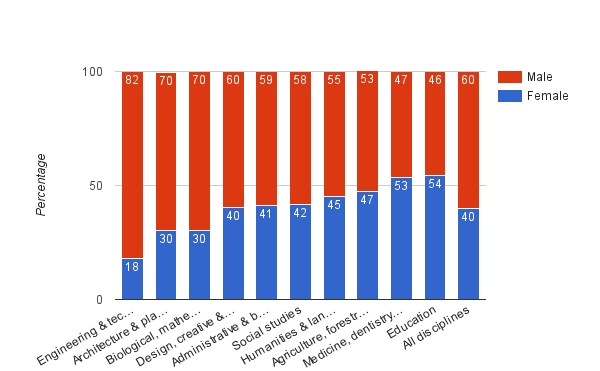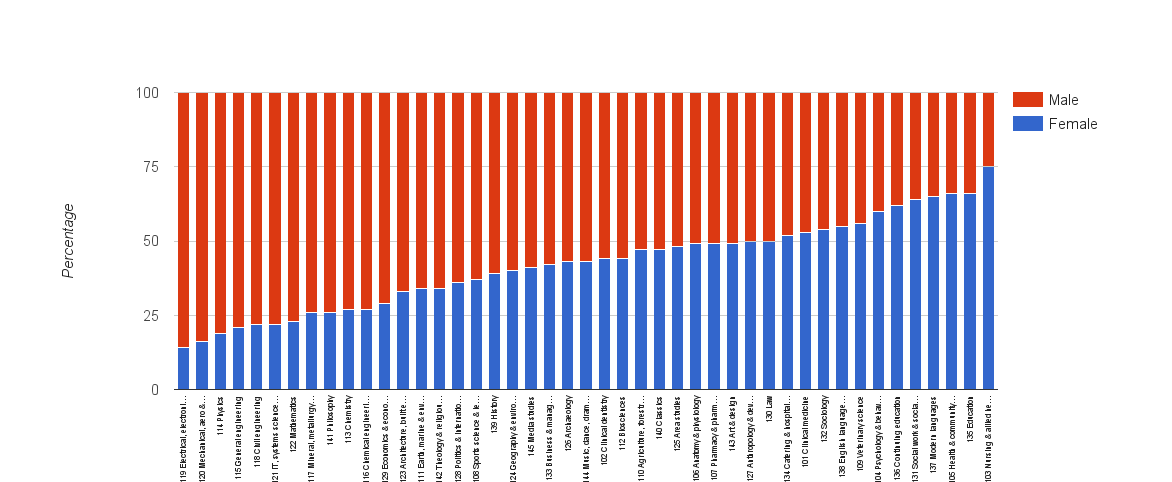How many women should you expect at an academic event?
Posted on 11 March 2016
How many women should you expect at an academic event?
 By Simon Hettrick, Deputy Director.
By Simon Hettrick, Deputy Director.
I’ve attended a lot of events during my time in academia, but I can think of only one where women outnumbered men (one of the BSA’s Science Communication Conferences). This is not a revelation, of course. It's well known that women are poorly represented at events: as keynote speakers, on expert panels, or just as attendees in general. When I've discussed this issue in the past, I've often been asked "How many women do you expect to see?". It’s a practical question, but not one I've yet seen answered.
Should the first target for an academic event be to simply mirror the population within the event's discipline? I’ve written this blog post with this principle in mind, but also to start a discussion about whether this is indeed a helpful target. It occurs to me that people must have already tried this, so I'd also welcome any data on these attempts and whether they successfully improved representation.
We're looking for equality of opportunity throughout academia, but this is a distant proposition in some disciplines. If we aim for representation as a first step, we provide a target that's easy to measure and possible to achieve. If an organiser can prove success at this first target - in other words, that they are representing the gender split in their community - it would help raise awareness of the event and this could help to further improve representation at later events. I realise that targets are fraught with complication, but they also give you something simple and quantitative to aim for. It's all too easy to lose sight of the bigger picture during the nerve-jangling panic of event organisation.
Just to set the scene, we can look at the UK population as a whole. According to the latest UK Census (from 2011) the UK population is split between 49% men and 51% women. (I note that this doesn't take into consideration other gender identities, but nor does the UK census, so we must work with what we have.) To look into the gender split within academia, we can turn to the Higher Education Statistics Agency (HESA), which makes available all kinds of information on the people employed in UK academia (albeit in a series of enigmatically named Excel spreadsheets).
HESA's "table K" provides data on the gender split in academia as a whole, and in different disciplines as defined by their top-level JACS codes [1]. In UK academia, across all disciplines in the year 2014-2015, we find a gender split of 60% men and 40% women. If you are running an interdisciplinary event, it would appear that this is your target if you want to mirror the academic community as a whole. However, the community varies from discipline to discipline, from the most male dominated - "engineering and technology" at 82% men and 18% women - to the most female dominated - "education" with 54% women and 46% men. There are only two disciplines ("education", and "medicine, dentistry and health") where women outnumber men. This of course raises the obvious question: why do men outnumber women in 8 of the 10 disciplines, when women outnumber men in the UK as a whole?
The following chart shows the gender breakdown across top-level JACS disciplines in UK academia in 2014/15.
I put this together in Google Drive, but if it proves useful I’ll put something more robust together. It’s an open document, so please take a look. (And since Google charts have an unbreakable habit of curtailing the length of an axis label, I’ve also copied below the list of the 10 JACS discipline titles [2].)
The problem with top-level JACS codes is that they munge an awful lot of disciplines together. I have a suspicion that biology has a more even gender balance than physics, but this distinction will be lost because they're classified together at the top level of JACS. I wanted to know more, so I bought the HESA report on academic staff 2014/15. The results of this finer analysis are shown below. Unfortunately, and slightly annoyingly, I can't share the analysis of this chart, because the HESA licence does not allow it (I shall work on this).
It’s a bit small on this page to be useful, so check out the interactive version which is more user friendly.
And now to the question I want to open to the community: should this be our target for events? If one were to run an event in Engineering and Technology should you expect at the very minimum 18% of the roles, everything from paper committees to steering groups, to be occupied by women? It’s far from equality, but is it a useful step towards better representation?
There are many complications which muddy the waters of this simple argument. The most obvious is that of seniority. Although one would expect conference attendees to mirror the gender make up of the discipline as a whole, keynote speakers and other senior roles are going to be occupied by senior academics. In my experience (in physics and computer science), men are significantly more likely to occupy senior roles in academia than women, and the HESA data certainly appear to confirm this. If we forego other measures and focus only on salary as an indicator of seniority (this time we need HESA'S "table B"), we find that across all disciplines men are twice as likely to occupy the highest salary band as women. This is at odds with the statistic described above, which shows that men only outnumber women in academia at a ratio of 60:40. This disparity in seniority may go some way to explain why there are more men represented in key positions at academic events, but again raises the more important question of why the seniority imbalance exists in the first place.
Personally, I think it's easier to improve a situation if one has a target, and I think it makes sense to set the minimum target to be that of representing the event's discipline. We should always be aiming for more, but on our way to this goal, merely representing the people who are already in the community seems like a step in the right direction. The more fundamental - and significantly more difficult goal - is to improve the gender balance, and to see that achievement percolate through all levels of seniority.
I note that there are many underrepresented groups within UK academia and we must aim to achieve representation across all groups. This is perhaps a discussion for another blog post.
Notes
[1]: Controversy abounds in this kind of discussion: not only are we dealing with the issue of gender representation, but now we must also face JACS data that clumps together subjects that do not always agree that they should be bedfellows. We do not want to enter that debate, we just want to work with the data that we can access.
[2]:
- Medicine, dentistry & health
- Agriculture, forestry & veterinary science
- Biological, mathematical & physical sciences
- Engineering & technology
- Architecture & planning
- Administrative & business studies
- Social studies
- Humanities & language based studies & archaeology
- Design, creative & performing arts
- Education



